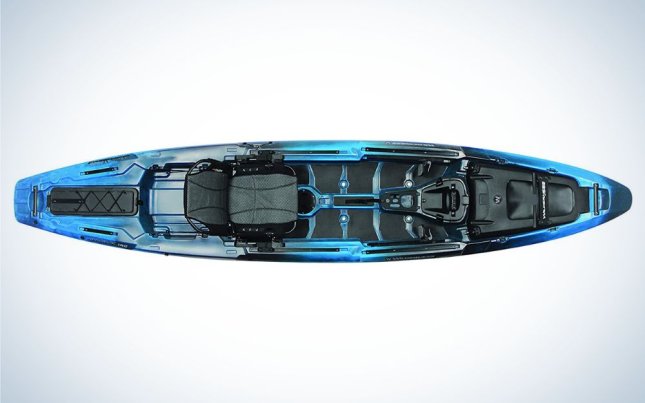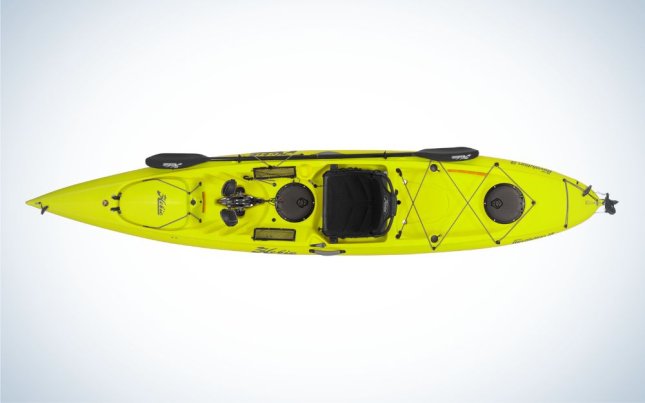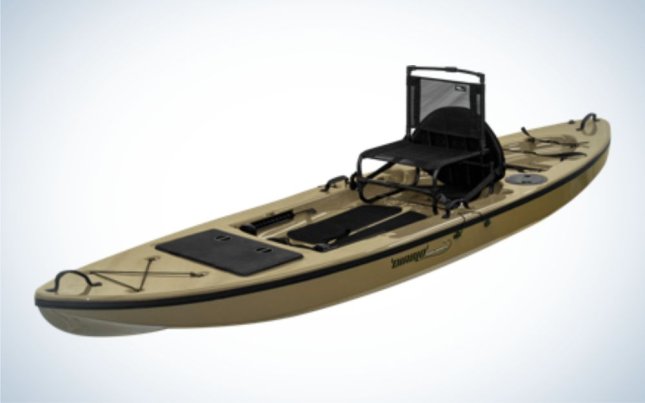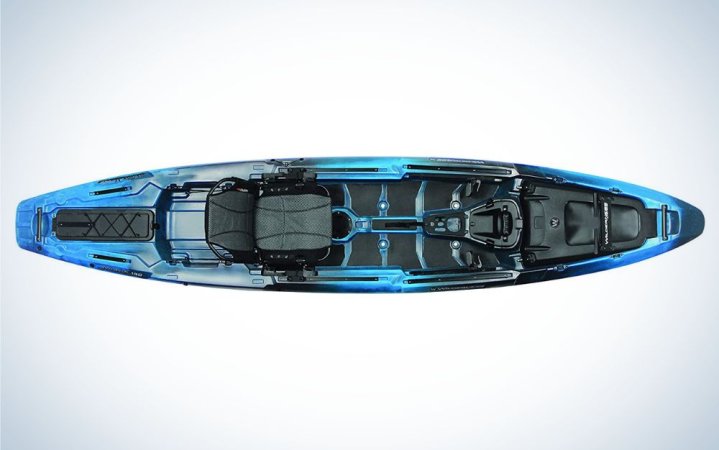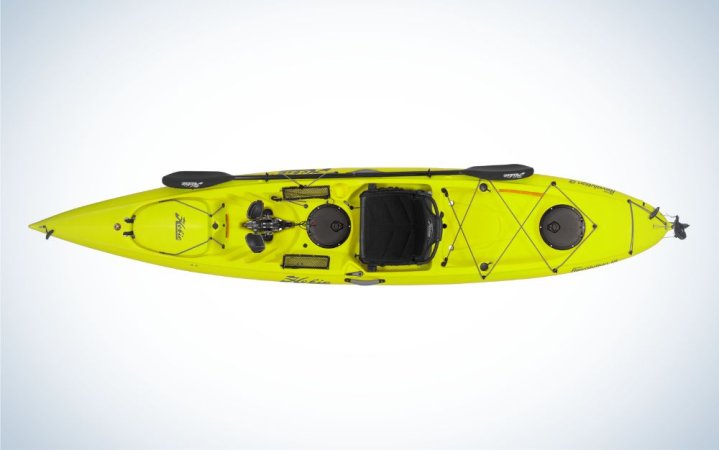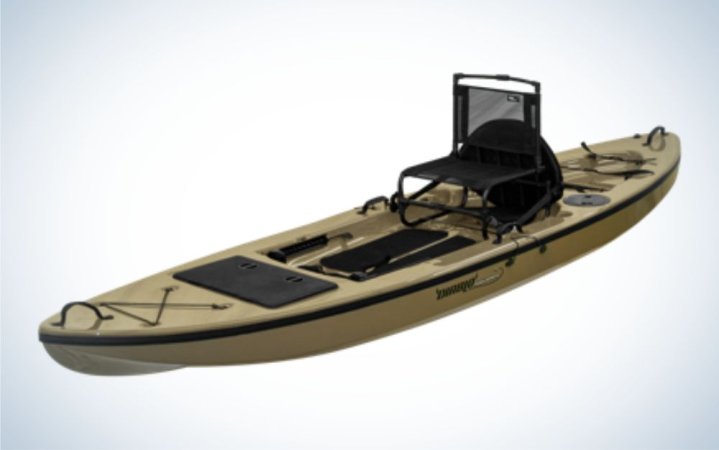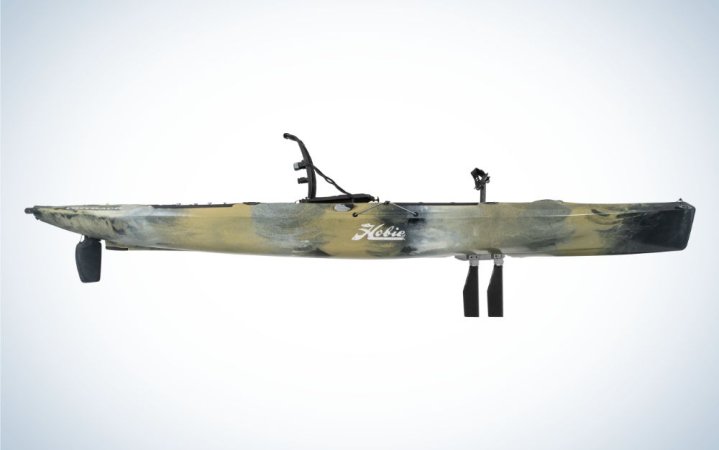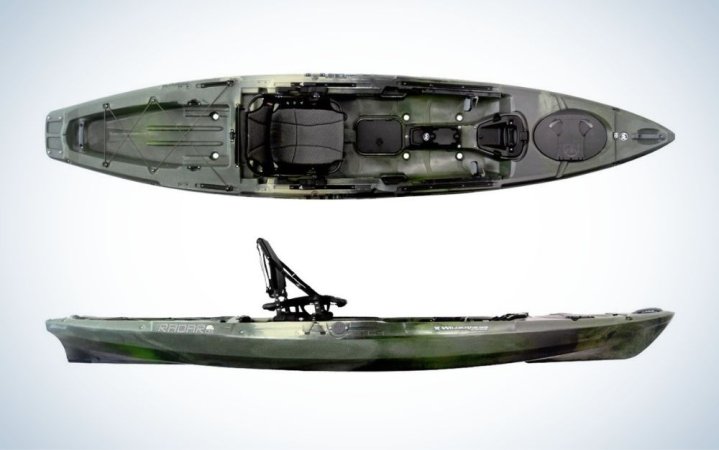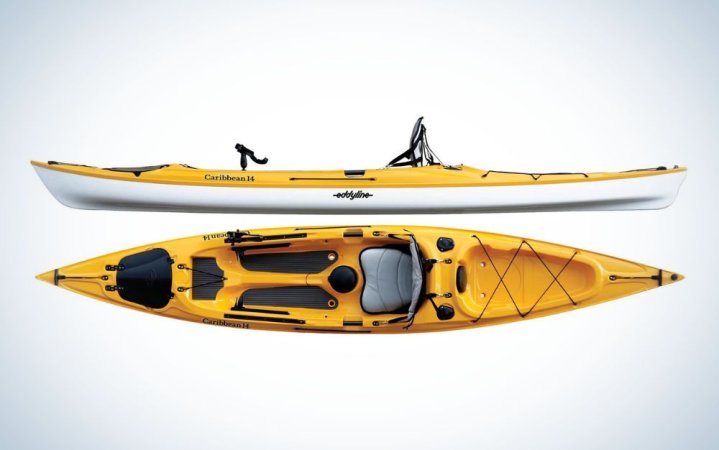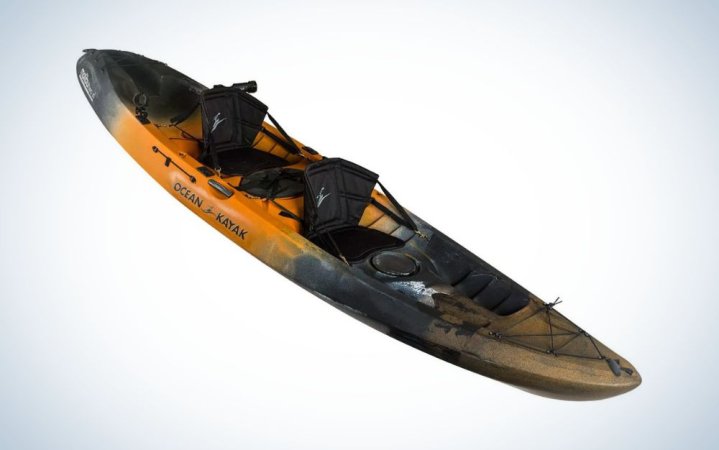We may earn revenue from the products available on this page and participate in affiliate programs. Learn More ›
Saltwater fishing pushes gear to the limits, and your ocean kayak has to take a lot of daily punishment while still getting you on fish—and all the way back home. When you’re giving it your all to land the fish of your dreams, make sure your gear can be trusted to hold up its end of the deal. The kayak that’s best for fishing the ocean is one that fits your budget, carries all of your required gear, and is comfortable enough to sit in through multiple tide cycles. I’ve made my picks for the best ocean kayaks and provided tops on how to choose the best one for you.
- Best Overall: Wilderness Systems A.T.A.K. 140
- Best for Offshore: Hobie Mirage Revolution 13
- Best for Inshore: Diablo Paddlesports Adios
- Best for Bay Fishing: Hobie Mirage Outback
- Best for Beginners: Wilderness Systems Radar 135
- Best Lightweight: Eddyline Kayaks Caribbean 14 Angler
- Best Tandem: Ocean Kayak Malibu Two XL Angler
Things to Consider Before Buying a Saltwater Kayak
What is the best kayak to use on the ocean? That’s a tough question considering the wide range of different fisheries across the United States, from hallowed offshore holes to precious inshore flats to expansive bays filled with fish. The long list of saltwater game fish that are the target species of the saltwater angler is even longer and hard to cover with a single boat.
When designers carve out the mold for the best fishing kayaks, important considerations of the hull design like kayak length and weight will influence the way it behaves on the water––all this before they start thinking about how to catch big fish from a kayak. Other key decisions like whether you paddle your kayak or pedal it to your favorite fishing spot will influence how you fish, the weight and price of your kayak, and many other factors.
Before you start looking for the best ocean kayak for your skill level, budget level, or type of fishery, consider these different design aspects of a fishing kayak:
Length
The first thing a paddler will ask you about your fishing kayak is likely the length, as a longer boat is generally a faster boat. Faster boats are not only quicker but will be easier to paddle for a long period of time. Anglers that have a long distance to cover would be smart to choose a boat that’s on the longer side, even up to 17 or 18 feet in length. Inshore anglers with a shorter paddling distance can get away with as little as 13 feet. Any short and you may be at the mercy of the tides and waves.
How stable are ocean kayaks? Length can be an important factor when considering how stable your kayak will be out on the ocean. Typically as boat designs get longer, the width will shrink to accommodate both weight and paddling comfort. The wider a boat is, however, the more stable it becomes, as a general rule, so keep that in mind when considering your skill level. If you’re a beginner, stick with boats wider than 32 inches. Experts can go as skinny as 28 inches but should avoid boats any skinnier than that.
Weight
As length and width increase on a saltwater fishing kayak so does the weight. There are ways to curb weight, such as switching to different materials, but often times the prices of those kayaks far outweigh the benefits. Kayak anglers tend to stick with rotomoulded kayaks not only for budgetary reasons but also because, for the cost, they are lightweight enough to transport to the water and handle well while paddling. That material also lends itself to getting beaten up season after season from the abuse of fishing.
When searching for the best ocean kayak for your needs, think first about how you’re going to get that boat to the water. Nobody wants to car-top a fishing kayak that is over 100 pounds, at least not more than once. If you have a fishing kayak trailer, weight becomes less of an issue. When considering weight, ere on the side of caution. The last thing you want is a boat that is too heavy, causing you to shy away from fishing when you otherwise would have been on the water.
Paddle vs. Pedal vs. Motorized Kayaks
The largest debate in the fishing kayak world a few years ago was paddle vs. pedal. Now that debate has largely been pushed aside for another more pressing issue: human-powered fishing kayaks vs. electric motor-powered fishing kayaks. Some fishing kayak brands have even folded motorized options into their product lines to meet the demand.
After spending time with plenty of kayak anglers, it seems like those who enjoy paddling for its own sake, or for budgetary reasons, stick with paddling. Those that would rather spend their time fishing, without worrying about using their arms for paddling, choose either pedal kayaks or a motorized option. Whether you choose to pedal or motor your fishing kayak to your favorite spot usually depends on budget, and sometimes weight. Before you start researching how to motorize your fishing kayak, consider the following list of best fishing kayaks for anglers that like to paddle or pedal their way to the fish.
Best Overall: Wilderness Systems A.T.A.K. 140
Best Ocean Kayak Overall
Key Features
- Length: 14 feet 1 inch
- Width: 34 inches
- Weight: 95 pounds
Why It Made The Cut
A good ocean kayak needs to be many things, including fast, stable, capable, and full of features designed specifically for the kayak angler. The Wilderness Systems A.T.A.K. 140 is the best example of a fishing kayak designed for the saltwater angler, as it has enough length to paddle across the ocean but with plenty of width for stability. Plus, the designers of this boat worked hand in hand with anglers to lay out the cockpit in the most efficient way possible to help anglers land more fish.
Pros
- Speed: The length and hull design of the A.T.A.K. make it slice through waves and tides.
- Flex Pod OS: The console in the center can hold a fish finder, or be swapped for pedals or motor.
- Storage: The large storage hatch in the front is big enough for a whole day of fishing, or more.
Cons
- Weight: At just under 100 lbs, the A.T.A.K. is better suited for trailering than car-topping.
- Deck Padding: Anglers that love to stand have some support, but the padding is a little thin.
- Rear Tankwell: The stern tankwell is a little small because of the rod storage taking up real estate.
Product Description
The open concept design of the Wilderness Systems A.T.A.K. 140 means anglers can tailor the fishing kayak to best suit their needs. The SlideTrax found throughout the deck, plus other available deck space for mounting other accessories means you can outfit the boat with any and all of the necessary gear for chasing down your target species, whether you’re fishing offshore, inshore, in the bay, or somewhere in between. It’s even suited well for freshwater fishing if you plan to take the occasional break from the ocean.
Offshore anglers will love the giant front storage hatch for keeping essential gear within reach. The rock-solid stability of the hull means accessing that gear is easy, and inshore anglers will love spending their day standing up to sight fish. The Phase 3 AirPro Seating is one of the most comfortable fishing kayak seats on the market and can be adjusted to multiple seating positions throughout the day. Kayak anglers looking for versatility will also love the Flex Pod OS in the center of the hull, perfect for mounting a fish finder or other electronics. It can also be swapped out for Wilderness Systems’ pedal or motor drive as well.
Best for Offshore: Hobie Mirage Revolution 13
Best Ocean Kayak for Offshore
Key Features
- Length: 13 feet 5 inches
- Width: 28.5 inches
- Weight: 88 pounds
Why It Made The Cut
Offshore anglers demand a lot of their fishing kayak, but mostly they rely on the boat for stability and speed. The Hobie Mirage Revolution 13 blends both of these characteristics of a fishing kayak perfectly, with a long, slim hull design that can cut through the waves and pedal long distances. It’s also stable enough to troll comfortably, fight and land fish, or simply relax after a successful catch.
Pros
- Twist and Stow Rudder: Pedaling over long distances requires a stout rudder system.
- Speed: The Revolution 13 is known as the speed demon of the Hobie lineup for good reason.
- Storage: The bow hatches and rear tankwell should hold all of your essential offshore gear.
Cons
- Price: At just over three grand, the Revolution 13 is a steep investment for some anglers.
- Carrying Handles: The older-style rope handles often get hooks stuck in them.
- Color Options: Hobie’s kayak lineup is lacking in colorways for their fishing kayaks.
Product Description
If you ever see a race between the best ocean kayaks and there is a Hobie Mirage Revolution 13 in the running, put your money on the Revolution 13. This is one of the faster ocean kayaks on the market, with a hull designed to cover serious distances easily. Pair that with turbo Kick-Up Fins and within just a few strokes of your legs you’re moving at full speed towards that distant pod of busting fish.
The open cockpit is large enough to handle long battles, difficult trolls, or landing large fish. The seat is comfortable and adjustable, to keep your boat feeling right, as well as breathable to keep it cool after many hours in the direct sun. Anglers sit up fairly high in the seat, and pair that with a narrow 28.5 inch width, this is a boat better for more experienced anglers. It is possible to stand in the boat, but it’s best to remain seated most of the time, especially when miles from the beach when fishing offshore.
Best for Inshore: Diablo Paddlesports Adios
Best Ocean Kayak for Inshore
Why It Made The Cut
Diablo Paddlesports is a smaller brand based in Texas, but their special lineup of fishing kayaks is definitely unique. Their Adios is an interesting blend of ocean fishing kayak and standup paddleboard, making it the perfect tool for stalking fish in shallow, clear waters. If stealth is of top priority, the Adios will be able to sneak up on fish more quietly, and on skinnier water, than many other fishing kayaks available on the market.
Key Features
- Length: 12 feet 5 inches
- Width: 36 inches
- Weight: 69 pounds
Why It Made The Cut
The Hobie Mirage Outback is more than capable of taking the position of any of the fishing kayaks on this list. It’s proven itself to be a reliable boat for both saltwater and freshwater year after year, and as Hobie updates its product line, it continues to get better.
Pros
- Weight: This is one of the lighter fishing kayaks around, and easy to car-top.
- Stability: The wide width means beginners and experts alike can stand in this boat without issue.
- Traction Pad: The comfortable deck padding means your feet can last as long as the sun does.
Cons
- Availability: The smaller brand means it’s generally harder to find at your local paddling store.
- Tri-Hull Design: While great for stability, the hull design doesn’t cut through stronger tides as other boats.
- Simplicity: Some may enjoy the minimalist design, but anglers looking for heavy features should look elsewhere.
Product Description
Inshore anglers need to stand up tall on a stable platform in order to spot and stalk their target species in skinny, clear water. Some anglers try fishing from a standup paddleboard but are left wanting with their storage and stability. Kayak anglers have plenty of rigging capabilities, and so does the Diablo Paddlesports Adios. Multiple rod holders mean anglers can carry many rods at once. The superior stability means that you can even fly fish from this kayak.
The Tri-Hull design of this fishing kayak means that while it’s one of the most stable boats on this list, it may not cut through the waves and tides as well as some others. If anglers are fishing in a location with steep, powerful tides, it’s best to avoid peak tidal swings and stick to the marshes or backwaters where fish will be waiting in the skinniest of water. The comfortable seat also sits high up off the deck to provide a better view into the drink, so you can spot fish earlier than anglers sitting flat on the decks of their kayaks.
Best for Bay Fishing: Hobie Mirage Outback
Best Ocean Kayak for Bay Fishing
Key Features
- Length: 12 feet 9 inches
- Width: 34 inches
- Weight: 103 pounds
Why It Made the Cut
The Hobie Mirage Outback is light enough to be carried by one person and is a proven performer for inshore and saltwater fishing.
Pros
- Speed: With the turbo kick-up fin pedal drive system, this boat can seriously move.
- Comfort: For a boat with simple rigging, you can spend all day in the saddle.
- Stability: You can fish and pedal all day without worrying about stability in rough waves.
Cons
- Weight: For a boat that’s under 13 feet, it feels heavy when fully rigged.
- Price: The Outback continues to get better, but that comes at a steeper cost.
- Length: The Outback is a little short for longer saltwater fishing excursions.
Product Description
There are some kayak anglers that upgrade their Hobie Mirage Outback every year to keep up with the latest updates to the boat’s design and for good reason. The Mirage Outback continues to get better every year, and anglers everywhere love its speed, its versatility, and its comfort. The turbo Kick-Up Fins also mean you can move across the water quickly with ease, covering long distances with just a few kicks.
The Mirage Outback handles itself equally well in large bodies of water or smaller ponds and lakes, but it really shines in the bay, when you need to move spots constantly to follow fish or adjust to the tides. Standing in the Mirage Outback is not as comfortable as Hobie’s Pro Angler kayak, but experienced kayak anglers won’t have a problem. Beginners should likely avoid standing in any kind of chop or while fighting fish. t through the waves and tides as well as some others. If anglers are fishing in a location with steep, powerful tides, it’s best to avoid peak tidal swings and stick to the marshes or backwaters where fish will be waiting in the skinniest of water. The comfortable seat also sits high up off the deck to provide a better view into the drink, so you can spot fish earlier than anglers sitting flat on the decks of their kayaks. Another plus is the Hobie Outback is easily rigged with Lowrance electronics, one of the best kayak fish finders.
Best for Beginners: Wilderness Systems Radar 135
Best Ocean Kayak for Beginners
Key Features
- Length: 13 feet 6 inches
- Width: 34 inches
- Weight: 90 pounds
Why It Made The Cut
Just because you’re just starting out, that doesn’t mean you don’t still need all of the features that a serious kayak angler needs. Rather than buying a simple, barebones boat, it’s better to buy a fishing kayak that will support your growth in skills over the years. The Wilderness Systems Radar 135 is a serious fishing kayak designed for anglers who like the option to paddle, pedal, or motor their way to the fish. The versatility means it can change along with your fishing tastes and skills.
Pros
- Features: This boat is beginner-friendly, but the design features everything an angler needs.
- Length: The length is the perfect length for new kayak anglers looking for a versatile boat.
- Rear Tankwell: The compact design still allows for a roomy rear tankwell for all your gear.
Cons
- Stability: Anglers can stand and fish in this kayak, but beginners should fish sitting down until they’re more comfortable.
- Scuppers: Beginner kayak fisherman like a dryer ride, and the small scuppers tend to drain a little slowly.
- Price: This boat is a great value, but it may seem steep for an angler just trying out the sport.
Product Description
Wilderness Systems didn’t pull any punches when they were designing the Radar 135. A boat that is versatile enough to paddle, pedal, or even motor to the fish with its Fled Pod OS system in the center of the hull, beginner anglers have the luxury of choice with this boat. The SlideTrax rail system throughout the deck means anglers can spend time getting to know the boat, and the sport, by spending some time rigging gear to their hearts content. Word of warning, you likely don’t need everything you think you need to get started.
The giant rear tankwell holds enough gear for a full day of fishing, even an overnight stay, and the front or center hatch provides even more storage. The boat is stable enough to access any of the hatches on the water, though standing is tougher in this boat, especially for beginners. Wilderness Systems Kayaks are a joy to paddle, and the Radar 135 is no exception. The comfortable seat is a dream to sit in for hours on end, so the first thing to wear out is your arms from improper paddling technique, not your backside.
Best Lightweight: Eddyline Kayaks Caribbean 14 Angler
Best Lightweight Ocean Kayak
Key Features
- Length: 14 feet
- Width: 29 inches
- Weight: 50 pounds
Why It Made The Cut
Fishing kayaks often get a bad rap for being heavy boats. Their rotomolded plastic construction means that they’re durable but definitely heavier than the boats typical of sea kayakers and touring paddlers. The Eddyline Kayaks Caribbean 14 Angler is the antithesis of that. Built with Carbonlite material, a blend of ABS and acrylic material, this fishing kayak is only 50 pounds, making it a joy to carry to and from the truck or car, and it handles like a dream on the water.
Pros
- Weight: This is the lightest boat on this list and makes carrying to and from the water easily.
- Speed: The lightweight boat moves quickly and easily through the water with a few paddle strokes.
- Capacity: Though it’s a light boat, this fishing kayak can still carry up to 350 pounds.
Cons
- Price: At just over two grand, this isn’t the most expensive boat on the list, but isn’t cheap either.
- Rigging Options: There is some gear track, but not as much as other serious fishing kayaks.
- Seat: This boat features an older style cloth kayak seat, which isn’t as comfortable.
Product Description
Lightweight fishing kayaks are few and far between, as fishing kayak designers tend to go heavy on features, rigging, hatch options, and of course, pedal or motor drive systems. The Eddyline Kayaks Caribbean 14 Angler is a lightweight fishing kayak designed for paddlers first, and anglers a close second. Kayak fishermen looking to fish on the ocean in a kayak that’s a joy to paddle and carry off the water will be pleased with all 50 pounds of this hull.
The fishing features of this boat are simpler, with two small hatches located close to the seat, and one larger hatch towards the bow. The seat is also the classic seat that is familiar to kayakers, but anglers that have fished on more traditional fishing kayaks are sure to miss those comfortable, ergonomic seats—this is not. Two flush mount rod holders behind the seat mean you can troll for target gamefish at high speeds, which might be the difference between catching fish that day and going home empty-handed.
Best Tandem: Ocean Kayak Malibu Two XL Angler
Best Tandem Ocean Kayak
Key Features
- Length: 13 feet 4 inches
- Width: 34 inches
- Weight: 73 pounds
Why It Made The Cut
Finding the best 2-person ocean fishing kayak takes careful consideration from both paddlers, as each of their needs has to be taken into account before finding the right boat. Paddling a tandem fishing kayak is also trickier than going solo, as frustrations tend to flare more easily when you’re both responsible for moving the boat and fishing at the same time. The Ocean Kayak Malibu Two XL Angler solves that problem by offering a simple, stable platform to fish in the ocean.
Pros
- Price: Even though two anglers can paddle this boat, you’re not paying double the price.
- Capacity: This boat can carry over 450 pounds, plenty for two anglers and all their gear.
- Weight: This two-person boat still manages to be light enough to carry by one paddler.
Cons
- Rigging: With two paddlers in the boat and a simple deck design, rigging options are lacking.
- Storage: While capacity is high, storage is limited to a smaller rear tankwell and small deck hatches.
- Bow Bungees: The kayak features simple bungees on the bow, rather than a sealed hatch.
Product Description
Tandem kayak fishing can be tricky, but it’s often the best way to introduce a new paddler or angler to the sport, especially if they’re one of your kids. Dogs also love the extra room that a tandem fishing kayak affords, as they can spread out without getting in the angler’s way. The Ocean Kayak Malibu Two XL Angler offers plenty of room and capacity in a simple, stable platform that will let two kayak anglers fish in the ocean at the same time.
The fishing kayak’s design features a center hatch for storing essential gear, as well as a small hatch in front of the bow paddler’s seat. A rear tankwell and small bow tankwell add to the storage, although there are no other sealed hatches, only simple bungees to store your gear. The fishing kayak’s seats are also the older style kayak seats, which may be uncomfortable for long days on the water, especially in rough conditions. Still, the Malibu Two XL Angler was one of the first tandem kayaks to solve the problem of two anglers wanting to fish together, and it continues to be a successful boat today.
FAQs
Sit-on-top kayaks are good for the ocean, in fact, they were designed specifically for the ocean. Sit-on-top kayaks have scupper holes in the bottom of their hull which allow water, from waves crashing over the desk, from paddling, or any other kind of water, to pass through the bottom of the hull and return to the ocean. This means sit-on-tops won’t sink no matter how wet your surf landings get, so they’re generally safer for fishing on the ocean.
In theory, yes, any kayak can be used in the ocean, however, some are much better suited for fishing in the ocean than others. The best ocean kayak is designed with enough length to make long-distance paddles and paddling against heavy currents or tides, much easier. They also generally have more capacity than freshwater kayaks, for example, since offshore anglers tend to spend long hours, and multiple meals for example, on the water. Do you need a special kayak for the ocean? Not necessarily, but as a general rule, even the best sit-in kayak is likely to be less suited for saltwater fishing than a budget sit-on-top fishing kayak.
One of the beauties of a quality ocean kayak is that you can use your saltwater kayak in freshwater as well as in the ocean. While your ocean kayak may feel a little large in some of your smaller ponds or lakes, especially narrow rivers, there’s no reason you wouldn’t be able to fish in freshwater with it. What is the difference between a river kayak and an ocean kayak? If you are fishing narrow, fast-moving rivers, however, the longer saltwater kayak may not be as nimble as necessary to navigate around rocks or other obstacles.
Final Thoughts
The best ocean kayaks for saltwater fishing need to blend a lot of crucial features required for landing larger, more powerful saltwater game fish, all in a package that’s a joy to paddle, transport to the water, and rig with all of your fishing gear.
The Wilderness Systems A.T.A.K 140, for example, has just the right length to be a long-distance paddler, without being a bear to handle in smaller, inshore conditions. It’s heavy, but not so heavy that it’s impossible to car-top, even on a lifted truck. It’s also comfortable, and versatile enough to handle any style of fishing you need for a successful day on the water.

